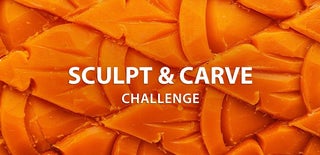Introduction: How to Carve Avocado Pits
Don't toss that avocado pit: it's easy to carve, and dries as hard as a rock!
Make a custom pendant or a brooch or a bolo tie or a hair thingy or a bead or a napkin holder or a stamp, or glue it to other stuff to make a wine stopper or a pipe or a walking stick or... okay I'm tired of thinking of things, your turn!
Supplies
Tools:
All you need are a few sharp tools. I mostly use "finishing" tools designed for folks who work with clay, and the little chisels and gouges from a very inexpensive wood carving kit, but almost anything pointy or stabby can be used on an avocado pit.
Use a pocket knife, a finishing nail, anything! Steal tools from a dentist! Use a porcupine quill! The tooth of an angler fish! My point is, and I cannot stress this enough: you very likely don't need to buy anything to try this out.
That said, I spend a whole lot of time carving pumpkins and such, and have developed a fondness bordering on the unnatural for tools made by "Xiem." They cost more than other tools, but they're super heavy and have a nice rubber grip, and they make me deeply happy. What can I say, the heart wants what the heart wants!
Note: carving fresh pits is easiest but they can be a little rubbery, so in some cases you might want to pause in the process and let your pit dry for a little while so it hardens up just a bit. In fact, some folks prefer to carve fully dried avocado pits, but those folks probably also like to carve rocks. The advantage to carving dried pits is that you won't be surprised by the inevitable shrinkage and possible warping that happens when a fresh pit dries, but you'll definitely need a more aggressive tool kit which includes the kind of tools folks use to carve hardwoods, like extra-sharp chisels and rotary burrs and files and profanity.
Avocado pits:
Any avocado pit will work. Bigger ones are a little easier to navigate, but tiny ones are still manageable. It's usually more trouble than it's worth to use a pit that's been scarred by a knife during extraction, so take care not to mangle the pit if you can avoid it. Some pits can be oddly shaped, which can be good or bad depending on your design, so it's a good idea to try to match the pit with the plan. For example, don't try lots of detail on a very small pit; save more intricate designs for a bigger pits that will better showcase your work.
Step 1: Be Careful
There are two aspects to avocado carving that can cause injury:
Avocado pit extraction:
This is apparently really dangerous, so handle this sinister fruit* with care!
Sharp tools:
The other danger is more obvious: you're using a sharp tool that can carve your hand just as easily as it can carve your pit, so you should always take a beat to think about the safety of each cut you're making. It's best to use the same precautions woodcarvers use, like holding your work with a cut-resistant glove. Also consider pressing your pit into a lump of modelling clay, so it stays put while you work!
Despite all precautions, if you do find yourself lacerated during the pit extraction or perforated during the carving, please do me a personal favor and think of a better story for how you got injured besides "I stabbed my hand while fiddling with an avocado." If you're asked what happened, I suggest you deploy the following two-word explanation: "knife fight." If prompted for additional information, just stare off into the middle distance and say "I don't want to talk about it," and then everyone will think you're this mysterious brooding figure with a dark past, instead of a pinhead who got wounded by a fruit*.
*Yes, it's a fruit. Botanically it's a berry with a big seed inside.
Step 2: Wait, Plan
Wait:
This is optional. You can jump right in a start carving immediately, but an avocado pit is covered by a papery "skin," which can be a bit of a hassle to remove when it's fresh. But if you wait a day or two (depending on humidity), the skin dries and wrinkles and breaks away easily.
Plan:
This is also optional; you can certainly jump in willy-nilly and start hacking away!
But avocados are "dicots," meaning they have two halves, like a peanut. As they dry, the halves (called "cotyledons") want to split apart from one another, so you'll get better results if you take a moment to locate the usually obvious line between the two halves. I've tried to get them to dry as a sphere with varying results (using gentle clamping), but the halves really want to shrink and warp as they dry, and the final product will have a visible seam.
So carve each half as separate designs for more predictable results, or come up with a design that has two hemispheres, like a brain.
I usually get a better end product if I use a reference, whether it's a doodle I doodled, or a photo, or a "sketch" in a lump of clay. A few easy ideas: a cheap little v-gouge will make quick work of simple shapes like Norse or Celtic runes, groovy religious symbols, a smiley-face, a peace sign, the name of your favorite person, or the logo of your favorite soulless corporation. Look to the interwebnets for inspiration; here are a few suggested searches: 1 | 2 | 3.
Or you can make weird 3D stuff like I do if you're in to that sort of thing, you weirdo.
Beyond that, there are very few limitations to what you can carve into an avocado pit, or carve an avocado pit into!
Step 3: Carve!
The carving process will vary depending on your design, your skill level, your tools, and the quirks of your chosen pit. Luckily the stakes are quite low: just compost your rejects and try again!
These examples were done using a v-gouge and a razor knife, with a little help from a clay tool that's just a wooden handle with a drill bit sticking out of either end.
If you're carving the halves separately, you can carve the inner, flat side, or the outer, convex side.
What you'll notice after a few minutes of whittling on an avocado pit is that wherever you cut into it, its beige color gets covered up with what looks like rust. Apparently that's because avocado pits contain a lot of tannin, which reacts with oxygen and turns red. It's super cool to watch!
You can make a cavity in your pit and press in a stone or a crystal or a bead or an eyeball, just be aware that the pit will shrink when it dries, so if the fit is too tight it might crack. The ratio of shrinkage will vary so you'll want to experiment a bit, but a colorful embellishment can look really striking against the dark reddish-brown of a fully-cured pit.
Step 4: Wait, Finish
Wait:
Once your pit is carved, it's a waiting game to see how it will turn out. You can sometimes nudge the direction of the drying process, but ultimately the final product will be a negotiation between the cuts you made, the structure of the pit you chose, the speed of drying, and the alignment of the planets. So at first it's best to be prepared for surprises, and don't get too invested in any one attempt!
Finish:
When your carved pits are fully dry, they feel like an exotic hardwood, almost rock-like. Their natural color is a mottled reddish-brown, which can be enhanced with a little mineral oil, though sometimes the tan color can persist past drying (see the attached image of the pit with the white stone embedded in it). There are likely several acrylic or oil-based clear coats that would also help bring out and/or preserve the color.
Paint is an option, but too much paint hides the material and loses you twelve coolness points.
Most of my carved pits to date have been just little balls of weirdness without any practical or even decorative purpose; they just kind of sit around being weird. I've only dabbled in making more useful items like jewelry, but I'll likely do more of that in the future. You should probably stick with that, too. I mean, how many balls of weirdness does the world need?
I've joined halves together with Gorilla Glue, but wood glue and many other adhesives will work, depending on what you're sticking to what.
You can thread a cord or chain right through a hole in a carved avocado pendant. Add a few store-bought or homemade beads to make a more ornate necklace. Or stick your pit to a flat metal pendant from the craft store, or to a magnet, or to a cork for the bottle of champagne you just opened as part of your "I just carved an avocado pit" celebration. Before mounting a carved half-pit to a flat surface, you'll always get a better bond if you first file or sand the flat side of the pit to flatten out the back.
You can join the ranks of folks who sell these at craft fairs and online, or make unique gifts for all of your friends and enemies, or just do an occasional carving for its own sake. It's fun, it's easy, and any schmuck with an avocado pit can do it.
Welcome to the tribe of avocado-pit-carving schmucks!

Runner Up in the
Sculpt & Carve Challenge













